Last Updated on August 26, 2021 by Colleen
Parkinson’s Disease is at epidemic levels–could an herbicide be a central reason?

Never heard of the herbicide Paraquat? You’re not alone.
How about Parkinson’s disease (PD)? We thought so.
Few of us are untouched by Parkinson’s – either within our family or friendship circles…or both. In fact, the number of people with PD increase almost 3x from 1990 to 2015 and is expected to reach nearly 13 million by 2040.
Many studies show a strong link between Paraquat exposure and PD. And, given that Parkinson’s is the fastest-growing brain disease in the U.S. (far outpacing Alzheimer’s), really, everyone needs to know about this herbicide and other toxic chemicals linked to it – and how to avoid them.
And, for some families with a history of PD, it’s particularly important. You see, they may have a specific genetic factor making them more likely to develop PD if they are exposed to Paraquat – a full 11 times more likely. But even if your family doesn’t have a history of Parkinson’s, Paraquat and other toxic chemicals still can lead to a PD diagnosis.
The net-net: Paraquat should be avoided – 100%. See the last section of this article for tips on how to avoid Paraquat residue on your food.
At ZEGO, we test our oats for Paraquat to verify their purity. See our purity test results here.
The Paraquat/Parkinson’s Link
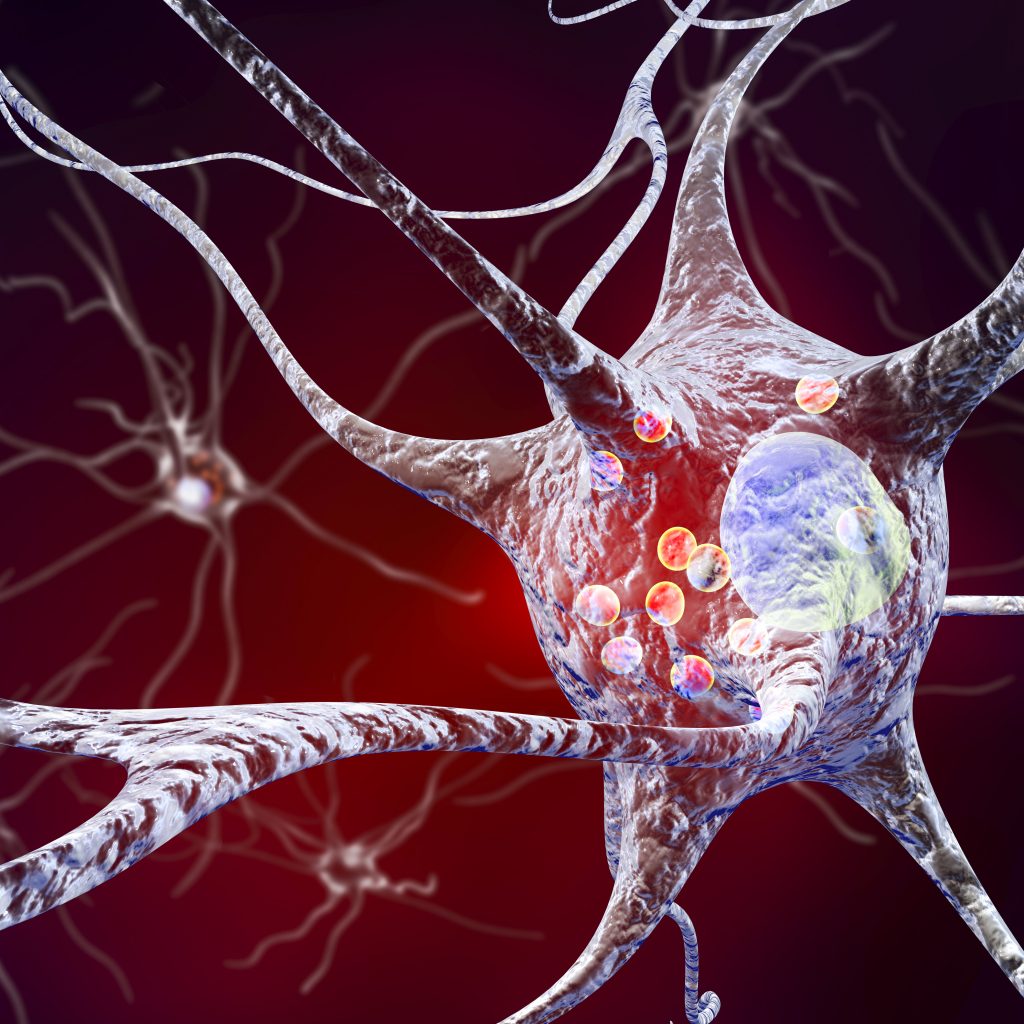
How do we know Paraquat can cause PD? The story is fascinating and tragic.
A Bay Area neurologist, Dr. WIlliam Langston, discovered a potential Paraquat/Parkinson’s link in the early 1980s. He was called into his hospital’s Emergency Room when a drug addict came in presenting with “zombie-like” movements. The patient’s symptoms had appeared suddenly. He was rigid and stiff and folding in on himself. Even more interesting, he still seemed to have his wits about him.
Dr. Langston did some sleuthing and found out five other drug addicts came to emergency rooms with the same symptoms around the same time. He also discovered they all had injected themselves with a synthetic opioid from the same batch. And, even though the synthetic opioid they took wasn’t itself toxic, Lanston found one of the drug’s component chemicals turned toxic when it entered the brain. And THAT chemical (MPP+) had damaged their ability to make dopamine – the chemical in the brain that controls motor skills. Turns out, this toxic component is similar in structure to the chemical used in Paraquat.
Unfortunately for these patients, some of their symptoms were irreversible.
Is Paraquat Responsible for the “Pandemic-Like” Increase in Parkinson’s Disease?
Many leading neurologists have published research implicating Paraquat and other pesticides like Chlorpyrifos (recently Pres. Biden announced the U.S. would ban this chemical) and Rotenone in causing PD. They also implicate another toxic chemical – Trichloroethylene – that is used for stripping furniture and removing industrial stains. Hundreds of studies have been done and papers written on the link between Paraquat and PD.
In fact, the Paraquat/Parkinson’s link is the most studied area of how an herbicide adversely affects the human body.
Most telling? Paraquat is used in lab rats to INDUCE the effects of Parkinson’s. Parkinson’s experts worldwide are working diligently to amplify the importance of this herbicide/disease link. In March 2020, Drs. Ray Dorsey, MD, Todd Sherer, Ph.D., Bastiaan Bloem, MD/Ph.D., and Michael S. Okun, MD) published a best-selling book, “Ending Parkinson’s Disease: A Prescription for Action,” stressing that continued widespread use of toxic chemicals, like Paraquat, is responsible for the “pandemic-like” spike in Parkinson’s cases. But they offer us hope as well. Since PD is largely a man-made disease, we have the power to unmake it. But it will take many people advocating for getting rid of these chemicals from our environment to do it.
This committed team of neurologists and neuroscientists also have other advice for avoiding PD:
- Ban Paraquat and Trichloroethelyne.
- Avoid activities that can lead to head trauma and wear a helmet when you do participate in such activities.
- Drink clean water.
- Breathe fresh air.
- Eat healhy.
- Reduce your exposure to chemicals at work.
- Exercise and enjoy your coffee (in moderation).
Ray Dorsey, MD, Todd Sherer, PhD, and Michael S. Okun, MD stress that continued widespread use of toxic chemicals, like Paraquat, is responsible for the “pandemic-like” spike in Parkinson’s cases.
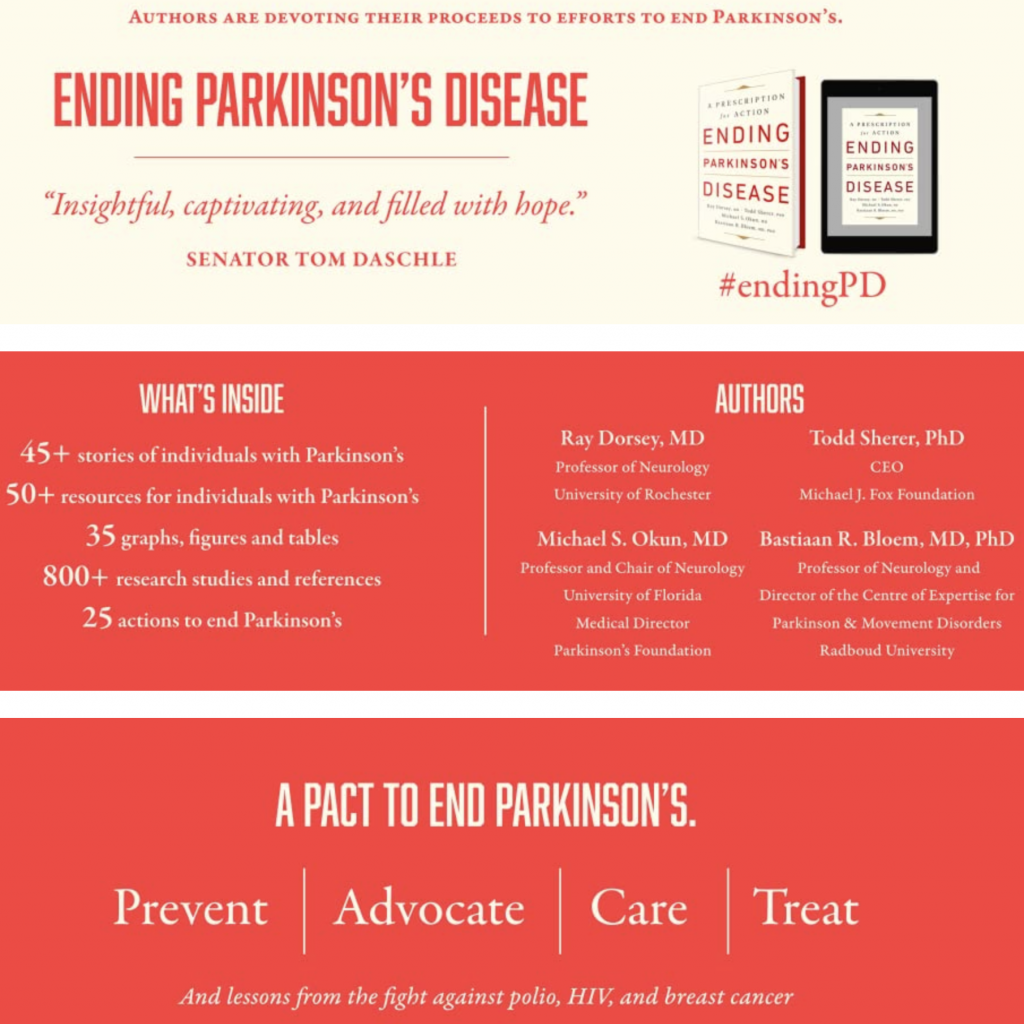
Who is Most in Danger from Paraquat Poisoning?
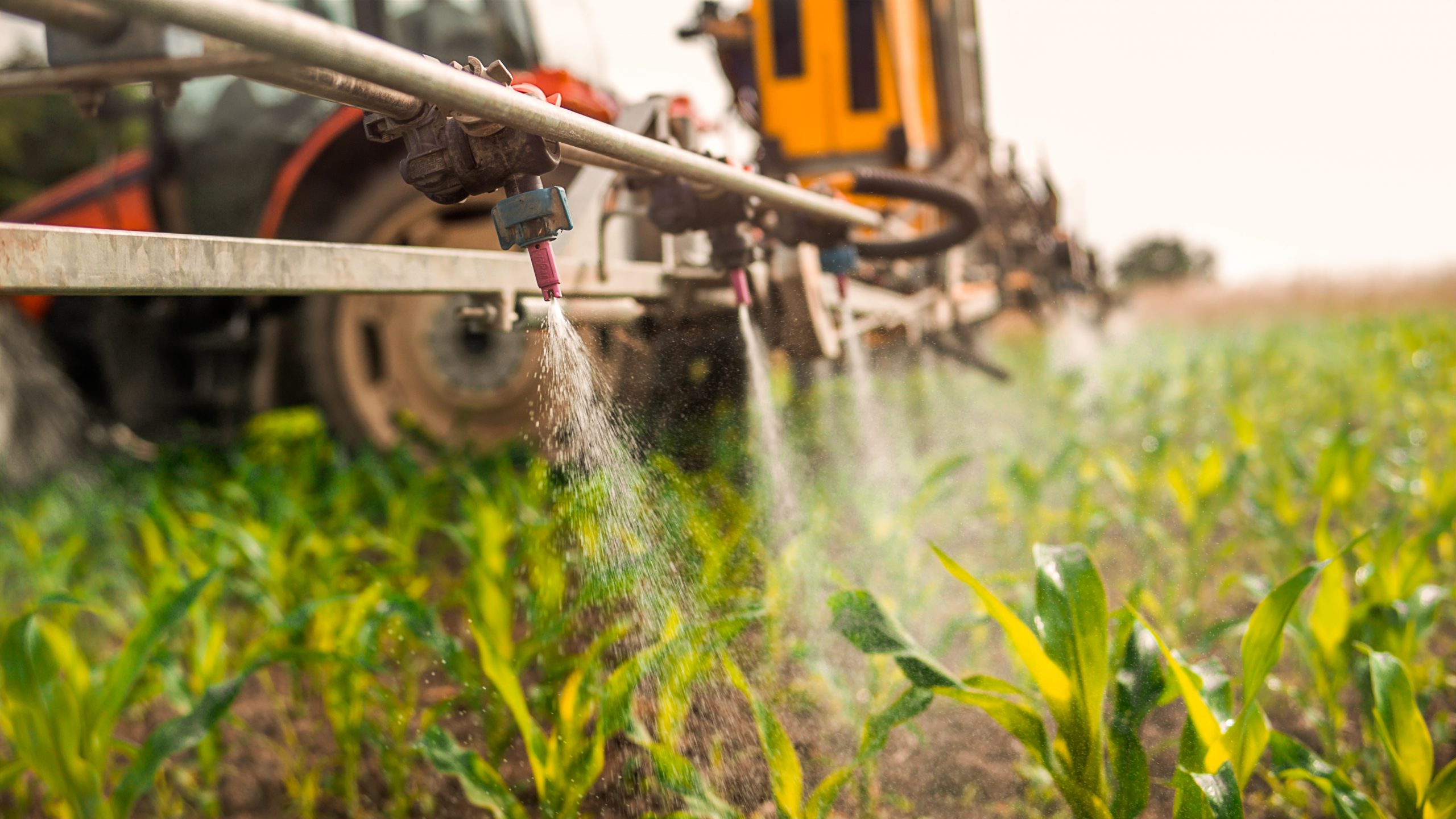
It’s not surprising that commercial farmers and workers spraying Paraquat are most at risk for being poisoned – either by inhaling or ingesting it. But their families – and anyone else living in or around farming communities – also are at risk.
How Are Consumers Exposed to Paraquat in Their Food?
Unfortunately, consumers may be exposed to Paraquat through residue on their food. This is particularly true when it is used as a drying agent or “desiccant.”
You already may know that Glyphosate (Roundup) is used as a desiccant – the same way farmers use Paraquat. They use these two chemicals so they can speed up the crop harvest by about two weeks – killing off immature sprouts and weeds – and making way for an easier harvest and replanting.
The problem is that using chemicals in late-harvest applications means that consumers have a higher likelihood of exposure to them – compared to when farmers use them during the downtime and/or in between plants and trees when they want to kill weeds between harvests.
Like Glyphosate, two of the primary crops farmers use Paraquat on for pre-harvest desiccation are oats and wheat.
In fact, as Glyphosate-resistance in crops increases over time, farmers are substituting or combining Paraquat for late-harvest application more and more.
We know that Paraquat-contaminated foods do end up at the supermarket – beyond oats and wheat. In fact, it’s been found in the commercial milk supply.
Oddly, despite how common it is for farmers to use, Paraquat is not a chemical normally included in pesticide tests. In fact, it is not part of the panel of over 400 pesticides for which ZEGO tests. We have to run a stand-alone test just for Paraquat. (FYI: herbicides are a subset of pesticides and distinguished as chemicals that combat undesirable plants.)
Why is Paraquat Especially Dangerous to Those with PD in their Family?
Some people have a specific genetic variation that puts them at higher risk of contracting PD if they are exposed to Paraquat. So, if you have a family history of Parkinson’s, hear this out:
• An astonishing 20% of the population has a genetic variation resulting in lower Glutathione levels in the brain.
• Glutathione is an important antioxidant that helps combat free radicals that can damage cells in your body and your brain.
• In a 2010 Agricultural Health Study of 89,000 farm workers who worked with Paraquat, researchers found those with this genetic variation to be 11 times more likely to contract PD than those without.
If Paraquat Is So Toxic, Why Use It?

Paraquat is a chemical weed killer used on more than 100 types of crops. It basically burns any vegetation it touches but becomes inactive when it hits soil. So, while it may drift when sprayed from planes or machinery, it does not wash into rivers and irrigation channels. And this is one of the reasons farmers like it.
- Farmers apply it to the soil during the winter months before the crops come up. This prevents weeds from growing in the off-season.
- They can speed up the growth season by drying up the extra greenery on the plants. This decreases unwanted moisture before the harvest.
- Because many weeds are or are becoming Glyphosate resistant, more and more farmers are supplementing with or switching to chemicals like Paraquat to kill the undesirable vegetation.
Interestingly, Paraquat has one upside, though it hardly makes it worth the PD trade-off. Farmers using Paraquat don’t have to till to control weeds. Tilling causes topsoil to erode more quickly, and that’s bad for both the topsoil and the planet.
What Countries Use Paraquat?
- Even though many companies around the world use Paraquat, most European countries do not.
- Switzerland has banned Paraquat, and yet it is home to one of the largest producers of this menacing herbicide.
- China has banned Paraquat, but the United States allows it.
- Japan allows Paraquat concentrations at no higher than 5%.
- Our own U.S. EPA allows concentrations as high as 30%.
In fact, the EPA recently reaffirmed it’s opinion that there is no significant link between toxic chemical herbicides and PD. Yet, the agency says that Paraquat is so toxic, people have to secure a “certificate of competence” to work with it.
You see, even in small doses, Paraquat poisoning can cause significant health problems, including:
- mouth pain and swelling;
- digestive issues, like nausea, abdominal pain, vomiting and diarrhea;
- confusion, seizures and coma;
- muscle weakness;
- lung scarring; and
- organ failure of the kidneys, heart, liver, and lungs.
ZEGO Tests for Paraquat to Verify the Purity of our Oats

We learned about Paraquat from our oat farmers. They told us that many other oat farmers use it as a drying agent. Late-harvest application means a much higher possibility of Paraquat being passed on to our customers compared to, say when farmers apply Paraquat to the ground around orchard trees before the fruit is on the tree. (But to be clear, we are not fans of using any toxic pesticides.)
We knew farmers used Glyphosate for late-harvest desiccation but had never heard of Paraquat. And then we thought: why is it that consumers don’t know about Paraquat? Why aren’t the nonprofits, news outlets, and Congress running tests on crops for Paraquat, like they are for Glyphosate and Heavy Metals, like lead and arsenic?
Our group of oat farmers is so concerned about Paraquat that they have signed contracts with one another saying they won’t use it on ANY of their fields – conventional or organic. That’s because they don’t want their workers being harmed, and they don’t want chemical drift to affect their organic crops. This is one of the many reasons why we love our farmers.
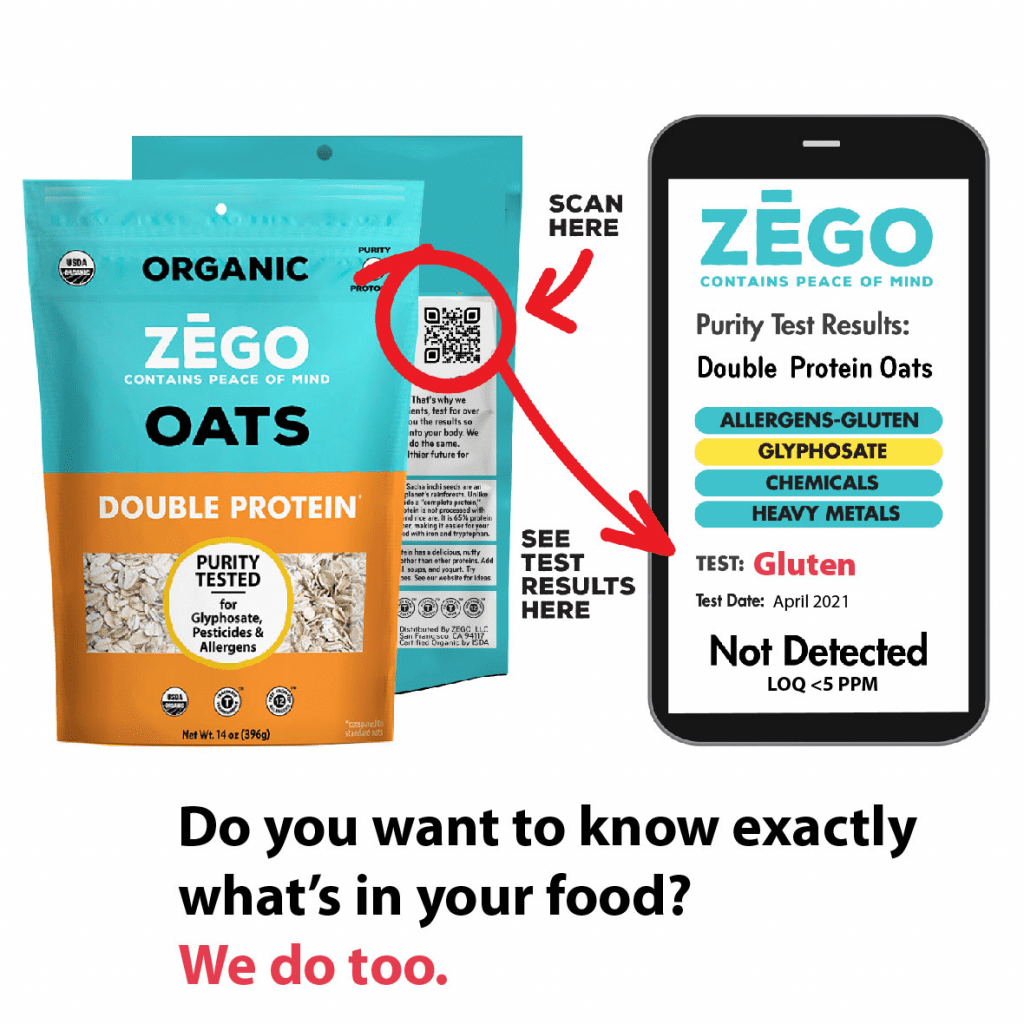
Since purity verification is our mantra at ZEGO, we test our oats for Paraquat to make sure there isn’t any residue on them. In fact, you can see our test results on our website by scanning the QR code on the package.
How Can You Protect Yourself from Toxic Pesticides?
- Only eat organic oats and wheat. Because organic crops can be grown side-by-side with conventional crops, you DO want to be aware of Paraquat drifting from one section of farmland to another.
- Contact the companies you buy from and ask them if they test for Paraquat. If they do, ask them what is their allowable amount in their products. Let them know that ZEGO tests and can show no measurable amount (<10PPB) in our Double Protein Oats. (Test results are pending for ZEGO Muesli, but we know the farmers who grow those oats have agreed not to use Paraquat.)
- Even though Paraquat residue risk is lower for other crops, try to buy organic produce when you can. Know where your fruits and veggies come from whenever possible. If you have a local farmers market, ask the farmers if they use Paraquat.
- Be sure to ALWAYS wash your store-bought fruits and veggies before you eat them.
- Enjoy ZEGO’s oats with peace of mind knowing we have verified their purity.
ZEGO is committed to transparency about where we source our products. We are doing the work, so you can be sure that our products are safe to eat.
-
 Organic Gluten Free Oats (14oz bag)$8.99
Organic Gluten Free Oats (14oz bag)$8.99 -
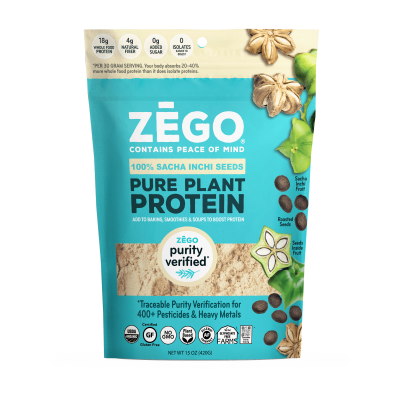 Organic Plant Based Protein Powder (15oz bag)$29.99 — or subscribe to save 10%
Organic Plant Based Protein Powder (15oz bag)$29.99 — or subscribe to save 10% -
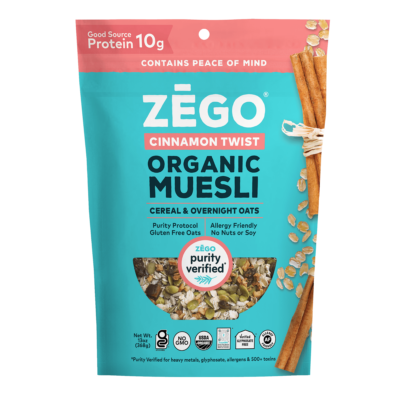 Organic Gluten-Free Muesli: Nut Free Cinnamon Twist (13oz)$9.99 — or subscribe to save 10%
Organic Gluten-Free Muesli: Nut Free Cinnamon Twist (13oz)$9.99 — or subscribe to save 10% -
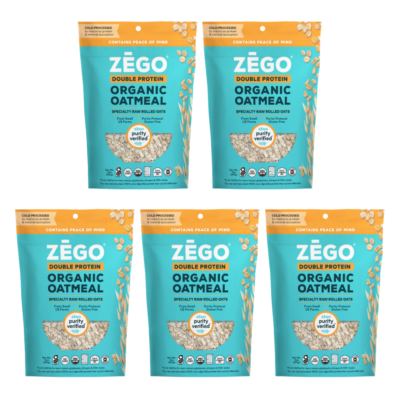 Organic Double Protein Oats 5 bag case$44.95
Organic Double Protein Oats 5 bag case$44.95 -
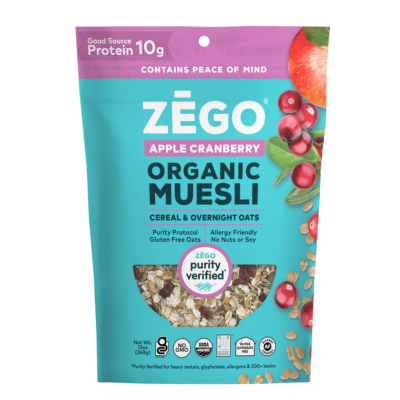 Organic Gluten Free Muesli: Apple Cranberry (13oz)$9.99 — or subscribe to save 10%
Organic Gluten Free Muesli: Apple Cranberry (13oz)$9.99 — or subscribe to save 10% -
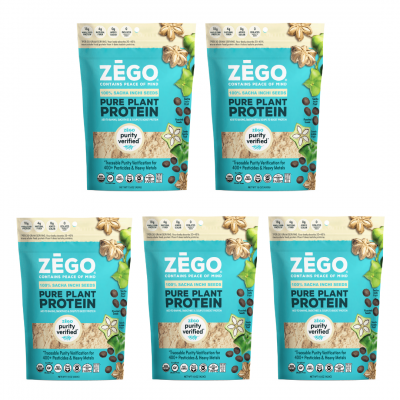 Organic Plant Protein (5 bags, 15 oz each)$129.95 — or subscribe to save 5%
Organic Plant Protein (5 bags, 15 oz each)$129.95 — or subscribe to save 5% -
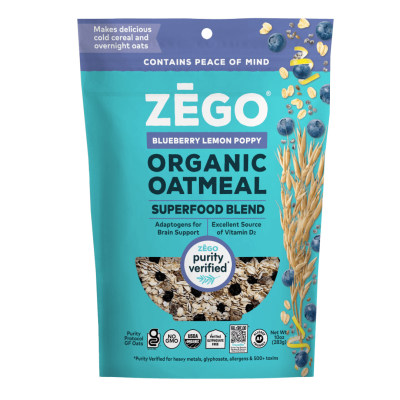 Organic Oatmeal Superfood Blueberry Lemon Poppy 1 Bag$8.99
Organic Oatmeal Superfood Blueberry Lemon Poppy 1 Bag$8.99 -
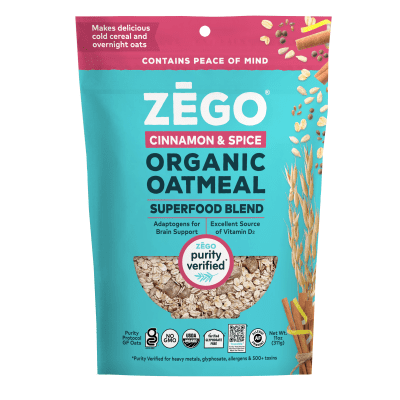 Organic Oatmeal Superfood Cinnamon Spice 1 Bag$8.99
Organic Oatmeal Superfood Cinnamon Spice 1 Bag$8.99 -
 Regenerative Organic Oatmeal – (21 oz.)$8.99
Regenerative Organic Oatmeal – (21 oz.)$8.99
